- The article clears the muck about Tantra, distinguishes between theology and philosophy and shows a demonic being’s response from hell. In Sanatana Dharma hell is a long purgatory and demons can become holy over aeons and through the grace of a sage.
Daniela Berti comments derisively that a “Tantric “specialist,” who also recites … mantras, may look down on temple mediums, yet at the same time also refer to a“possession logic” when he claims, as happens in some regions, that a god is sitting on his tongue or on his back” (qtd. from Spirit Possession: Multidisciplinary
Approaches to a Worldwide Phenomenon edited by Éva Pócs and András Zempléni, 394).
Can Berti write of this logic about any other religion? Can anyone write that a Roman Catholic priest or a Protestant minister is a ‘specialist’ in reciting mantras since all Christian liturgy consists of set formulae (mantras)? Will Éva Pócs publish a chapter like the one she has published by Daniela Berti? And, a Tantric is a specialist to begin with.
One cannot be a Tantric in the strictest sense of the nomenclature unless one’s vocation is to be a Tantric within Sanatana Dharma. This is not a career-decision that one takes after passing a few examinations or writing inane books on the topic or teaching it in some institute of higher learning. It is a direct anthropomorphic call by the Supreme Godhead manifested as Mother qua Shakti. Shakti is not feminine; nor is it an attribute of the Supreme Godhead. Shakti or Power is God who calls by name the human person in the here and the now. This is equivalent to having a clerical vocation within Christianity.
In passing we must remark that the observations in this essay also accomplish their cultural work by entering into dialogue with Roman Catholicism. Interreligious dialogue is not the prerogative of celibates of either religion. Tantra, and Tantric modes of worship are the main mode of worship within our Dharma and therefore there is an urgent need for Tantra to enter into dialogue with Abrahamic religions.
This brief essay is a rebuttal to the likes of Daniela Berti and Éva Pócs.
Tantrics do not chant abracadabra. This derision comes from a lack of having a vocation to this sacred ‘marga’ or path. One does not turn to René Girard to learn of Jesus Christ and the scapegoat theory. One turns to the likes of Karl Rahner SJ and John Caputo to know of the weakness of God as conceived within the Christian economy of salvation. God in Christianity is not weak in the sense that weakness is an opposite of strength. For understanding God’s weakness which is central to Christianity, refer to The
Weakness of God: A Theology of the Event by John Caputo.
Similarly, one sees through the eyes of
faith what those with vocations to Shakta Tantra have to say and show to the
world for a deeper understanding of this much maligned path.
In the next section we will delve into
the differences between theology and philosophy
since this difference is crucial to both our interreligious dialogue and also
to a fuller understanding of Shakta Tantra.
One becomes a Christian by professing faith in the resurrection of Jesus, the Christ. That is, Christ rose body and soul to heaven after three days of His crucifixion. St. Paul says in the New Testament of the Bible that Christianity revolves around this truth of that faith. If Christ did not rise from the dead, both with His body and soul, then Christianity cannot exist. Can anyone prove that Christ rose up from His tomb? No.
Therefore, this is known as a Mystery
of the Christian faith. This assertion is beyond the realm of reasoning or ratiocination. If one misreads Immanuel Kant’s works then through this distorted neo-Kantianism leading to logical positivism, one will come to question this basic assumption of Christianity which, to begin with, is not within the realms of philosophy, but is solely to be answered through the prism of Christian theology. The response to the Mysteries of the Christian Faith cannot be through materialist hermeneutics. To answer or, interrogate them through structuralist critiques is to mix up the categories of philosophy and theology in their strictest non-interdisciplinary sense.
This is the error we commit when we mix up the
theological element with the philosophical element, when approaching our Dharma,
in the misplaced belief that we are practicing interdisciplinary studies.
Philosophy is philosophy and theology is theology.
Philosophers follow the scientific
method in their derivations. Theologians follow the
scientific method to the fullest extent permissible to explain the mysteries of
their faith. For instance, the assertion that God exists is dealt with
differently by philosophers and theologians. Philosophers may agree with the
assertion or disagree with the assertion. They depend solely on logic informed
by methods of knowing, or epistemology. For them God is an episteme; or a quale
that is epistemologically verifiable. If philosophers feel that the problem of
evil is insurmountable, then they will reject that quale as epistemically
improbable. They might conclude that God cannot exist given the insurmountable
problem of evil. Religions have consistently failed to offer acceptable
theodicies to philosophers of every kind. Logical positivism and nihilism are
philosophical responses to the problem of evil within Christianity.
Theologians on the other hand, do not have the liberty
to deny the existence of God. If they denied the existence of God, they would
no longer be theologians. Theology begins with the
acceptance that the existence of God is a matter of faith and not debate. If one’s theology shows there is no God, then it is no longer theology but a philosophical critique of the metaphysical statement that God indeed is.
So, when we speak of our Dharma as a distinct religion
and not merely as a way of life; the latter is a relativist fallacy; we must
first declare the cornerstones of our Faith.
If these are missing, we are certainly not followers of Sanatana Dharma:
1. We assert that God exists. Everything is sustained
by God. Without the magnanimity of God, not even a leaf moves.
2. We assert that our actions, both interior and
exterior, have profound consequences for this life and uncountable lives to
come. Karma is real.
3. We assert that evil exists, but it is not absolute.
This is not to say that radical evil does not exist, nor is it to say that
human culpability in evil actions is mitigated by the existence of evil but we assert
that the perpetrators of radical evil in this and many other lives can change
themselves to become better beings. Hells are not eternal within our Dharma.
The intended audience of this essay is the Hindu Faith
community. It is not my responsibility as a theologian of my Faith to empirically
justify the theological project in hand to anyone who is contaminated by
Kantian doubts and logical positivism or has no respect for my Dharma.
This is not a fallibilist theology of Tantra but a
definitive statement about the verities of Tantric worship or, hyperdulia. Each
photo is followed by a commentary primarily meant for scholars.
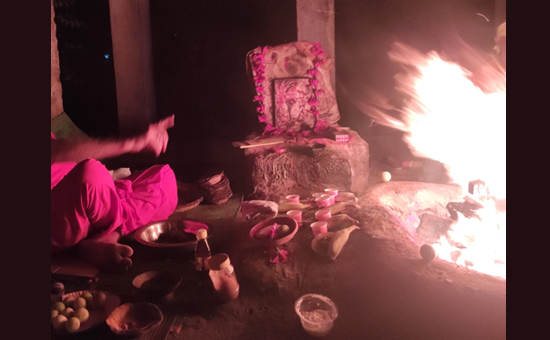
In Shakta Tantric worship as practiced in Assam, West Bengal and parts of Odisha, the Tantric adept invokes entities from different spheres of the different realms including the various hells or ‘patalas’. These are not cognate with Abrahamic eternal hells. They are akin to extended purgatories. The adept calls these spirits and asks them to work for the good of the world and in return, they are given the chance to be born as humans.
Human birth is invaluable and thus these demonic beings get an opportunity to proceed to mukti. In the photo above, taken at Tarapith in West Bengal, we find this entity trying to attack the practitioner. For those with eyes to see, the fire is trying to attack the Tantric yogi who is teaching it the ways of mukti. There is nothing transgressive about it. This is in the ‘shamshan’ or (main) old, non-electric crematorium of Tarapith, adjacent to the temple of Maa Tara.
Before this entity was summoned, Sages Vashishtha,
Vishwamitra and Baba Bamdeb (Vamdeb) were invoked for their permission for
summoning this entity. Without their blessings Shakta Tantric rituals at
Tarapith will fail. This ritual cannot and should not be done by one who is not
initiated in this lineage; nor should anyone try to invoke demonic entities at
home or in crematoria. Most go mad finally doing these. It is forbidden in the
Tantric scriptures to invoke these beings without being perfectly
self-controlled.
In this case the sadhaka invoking this entity has
become one with the One.
Without the protection of the Ten Mahavidyas such a
ritual will lead to great harm for those involved in this life and other lives.
In this case, the invocation of the entity was done for public good. To wish ill of others leads to certain spiritual death. Notice, no women are present here. Tantra is not about eroticism and is far from it. If there is eroticism present, it is not Shakta Tantra, but something perverted in the name of Tantric praxes. The terms ‘demonic’ and ‘demon’ and ‘evil’ are not used here in the Abrahamic sense. These beings were once human like you and I. But due to the great harm they did to others over lifetimes, their ‘Karman’ has caught up with them. They are trapped in solipsistic self-created hells from where none, but a sage can give them mukti. This is the process you see in the photograph above.
There are other photographs with this author which
cannot be published since there are injunctions against them in Shakta worship.
This photograph and the others here have been published through proper
lineage-permissions. The reader is warned not to download these photographs
since nothing good will come from them unless one is trying to help others by
doing so. More than this nothing can be revealed.
Picture 2 is of a betel leaf and a candle providing protection from unwanted beings within the ritual space. Nothing can enter or escape the ritual space. It is lit for protection. If this is not done then the entire ritual will be destroyed and those present run the risk of dying or at least, going mad. This madness is not mental ill-health but a total takeover by evil beings. If the rituals go as our Scriptures teach us and the lineage dictates, one will hear and see wonderful and uncanny things but will not be harmed. Again, do not even try these by yourself and never at home. These are charnel ground rituals and performing any of them at home will destroy that family including the practitioner.
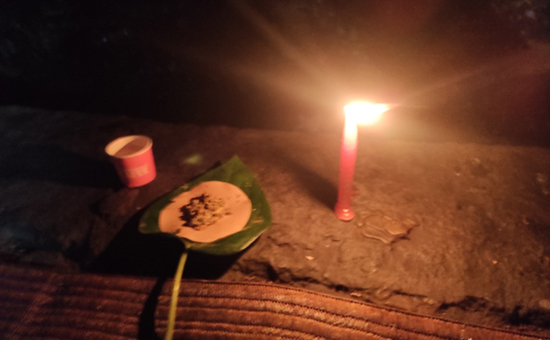
Remember it is dangerous to not take adequate protection before
performing these rituals. There is no black magic
involved. This is pure Shakta worship --- that is, the worship of God as
Power and Mother.
Why is it dangerous to perform these at home? Rather, why are these rituals
done only in charnel grounds?
Tantric deities and beings invoked during these rituals inhabit the
charnel ground preferentially in the same way that Roman Catholics believe that
the Holy Angels are preferentially present in a Roman Catholic Church during
the transubstantiation which occurs during the Holy Eucharistic celebration. During the Holy Eucharistic celebration by Roman Catholic
priests, the bread and the sacramental wine are changed into the Body and Blood
of Christ.
If none have problems in believing in the transubstantiation, then certainly one cannot have philosophical or theological problems in accepting our Dharma’s deepest truths. It is sad and unfortunate that these rituals are often rejected by cynics as being heathen and pagan. The greater misfortune is that normative Hindus mock and sneer at what they do not understand. They call this ‘kala-jadu’ or, black magic. They fail to comprehend that the need of the hour is to study logic and epistemology to even begin to talk about these rituals.
Recently one sees online and on OTTs the theory that the Burari deaths
were due to Tantra. If any child or women are killed ritually, there is a media
frenzy in calling them deaths due to Tantra. It is like saying that if one
kills in the name of Christ, the murderer represents Christianity. Christianity
is best exemplified by St. Francis of Assisi who in a mystic fervour gave away
all his wealth and clothes to serve the poor. Christianity is not to be blamed
for some fanatics decrying Hindus as heathens.
Similarly, true Tantrics are contemplatives and recluses, and they no
longer live in crematoria since the aim of Shakta Tantra is to deify the body
in the here and the now. The nitya-puja of Tantrics is all turned inwards and
has nothing to do with exteriority and simony. If there is a whiff of money,
then it is not Tantra. Tantric rituals cost money in the way of transport, in
the way of buying Tantric oblations like certain fruits, vegetables and wood
for the sacred fire. Even time at crematoria is charged by the hour. Beyond
this there are no charges involved.
The Burari deaths contrary to YouTube information and online streaming series were due to mass hysteria, now categorized by psychiatrists as ‘folie en famille’ or shared psychotic disorder (shared delusional
disorder). If the mental health care workers had intervened, then nobody would
have died. Newer atypical antipsychotics would have cured the shared delusion
that their dead ancestor was guiding them and asking them to become suicides. Children
and women and others are often killed in the name of Tantra by unscrupulous
women and men who are just murderers wanting to eliminate invaluable lives for
their own selfish ends.
The holy Tantric
scriptures nowhere ask anyone to be killed, nor do they advocate violence
towards anyone else.
Bollywood has done incalculable damage to our Dharma through wrong representation of the aims of Tantra. Now, self-proclaimed Tantrics in colourful dresses are fearmongering online. One keeps wondering why these Tantrics online and offline do not end poverty and income inequality and prevent extreme weather phenomena?
Instead of asking people to seek psychiatric help when then need it they are busy finding non-existent supernatural causes to natural evils. Couples at the point of divorce instead of seeking therapy are running to fake Tantrics for help and they are encouraged by both the Indian movie-industry and by Western peddlers of erotica which sell like nothing else in the world. This author is monogamous and cannot even imagine being otherwise or, of ‘doing’ weeds and he has been in this path for some time: he wonders what has been the reason for the attack against Tantra?
The answer is
resoundingly this: Tantra is a victim of over eager
Western scholars who have no idea about this path.
For instance,
Hugh B. Urban declares in page 14 of his Introduction to his puerile
book, The Economics of Ecstasy: Tantra, Secrecy, and Power in Colonial
Bengal, that his intention is to “engage the more problematic side of secrecy as a source of scandal and embarrassment—above all, with regard to Tantric sexual practices—and the corresponding "metastrategies " of self-censorship, concealment, deodorization, and disguise which esoteric tradition s must often employ in order to protect themselves”. Urban even names Chapter 6 of his book, The Stinking Fruit in the Garden of Love! One wonders with whom Urban
mixed while doing his fieldwork.
Where did he find these ‘metastrategies’? How is it that this author who is a regular at Tantric sites never found these strategies. Urban suavely polishes off his hocus pocus scholarship by quoting Frank Kermode of all people. In page 15, he sections off his Introduction with the sonorous division: “The Torment of Secrecy: Methodological Problems in the Study of
Esoteric Traditions”. There he epigraphs the section through a quotation from Kermode’s The Genesis of Secrecy. Now Kermode is one of the greatest literary critics who ever lived and a great Bible scholar.
To apply Kermode’s theory to Shakta Tantra in colonial Bengal must be making Kermode turn in his grave. Yet Hugh B. Urban through sleight of words and quotations muddies the waters of Tantra by harping on the erotic. The Hebrew Scriptures in the Bible have The Song of Songs to show metaphorically the intimacy of
YHWH with humanity. Does the presence of The Song of Songs make
Christianity esoteric and/or erotic?
Scholars like
Hugh B. Urban have done incalculable damage to the academic discipline of
Shakta Tantra probably not out of malice, but simply because they embarked to
research and write on something to which they have no vocation. They are out
there to score academic brownie points in various Academies of Religion.
In page 166 Urban attacks Sri Ramakrishna Paramahamsa as being ashamed and “torn in his relation to Tantra”. Who is Urban’s source here? Naturally, another scholar contaminated with the world and lust --- Jeffrey John Kripal whom the living Body of Sri Ramakrishna, the Ramakrishna Math and Mission headquartered at Belur, Howrah, West Bengal has decried repeatedly as being outright perverted, is the sole source of Urban’s knowledge of Sri Ramakrishna Paramahamsa. Jeffrey John Kripal is mentioned clearly and quoted in page 166 without any scholarly discrimination.
If this is Urban’s uncritical approach to Sri Ramakrishna, we can only expect muck from him and others who cite him. It has been the misfortune of this author to see students being taught John Kripal on Sri Ramakrishna in seminars from which he had to walk out in disagreement. If Sri Ramakrishna was so ‘torn’ about the purported obscenity of Tantra, then why did the Ramakrishna Order in its global mouthpiece, Prabuddha Bharata, dedicate its annual special issue
entirely to Tantra? Monks, scholars and this author too contributed to that
volume. Yet the academic world reads and lauds Kripal and Urban.
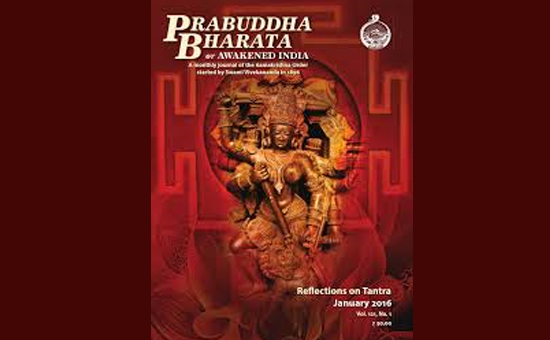
Another
example of erroneous scholarship will prove the point that women and men
without vocations to the Tantra marga, misrepresent it entirely. Studies on
Tantra in Bengal and Eastern India edited by Madhu Khanna and published by Springer, is another such book. The book verges on the pornographic. It is the aim of this author, following his Gurudeva’s commands, to show the world the reality of Shakta Tantra. Unless we Hindus rise to defend Tantra and learn about this way or, ‘upaya’ to achieve mukti, we will have Kripal, Urban and Khanna systematically destroy our Dharma.
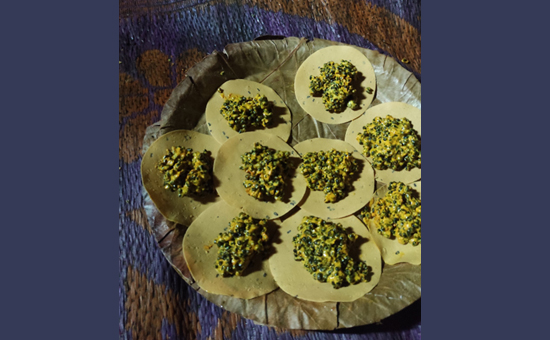
This is a close up of the offerings to different Deities. These are needed in Shakta Tantric worship. There is nothing esoteric about these. These are finally consigned to the sacred fire or havan/homa. The base is the humble papad. Again, this is not something to be done at home or without proper initiation. Even then to be done only with the permission of one’s Gurudeva. Somehow structuralist scholars do not focus on these aspects of Shakta worship. They keep reiterating non-existent antinomian rituals. Nothing is antinomian.
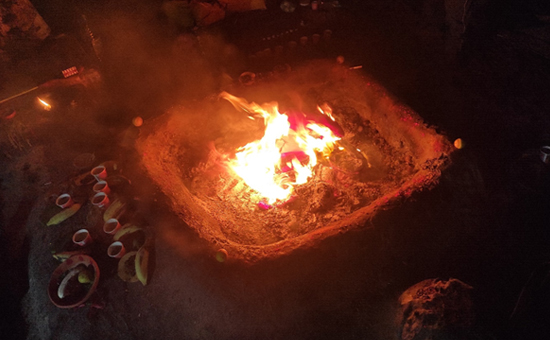
This is the final step of the worship or Puja. In this particular instance, the Mothers Tara, Bagalamukhi and Chamunda are being invoked. The long ritual spanning hours ended with chants by all present of the glories of these three Mothers. Mother Chamunda particularly was worshipped. There is nothing ferocious about any of them. Is one afraid of one’s own Mother? Then why be afraid of Maa Chamunda? Notice the lemons and the cigarette which was offered earlier during the deity possession phase of the ritual.
Harih Om.
Dr. Subhasis Chattopadhyay is a theologian with special interests in Shakta Tantra and separately, in Roman Catholic theology.
To
read all articles by author